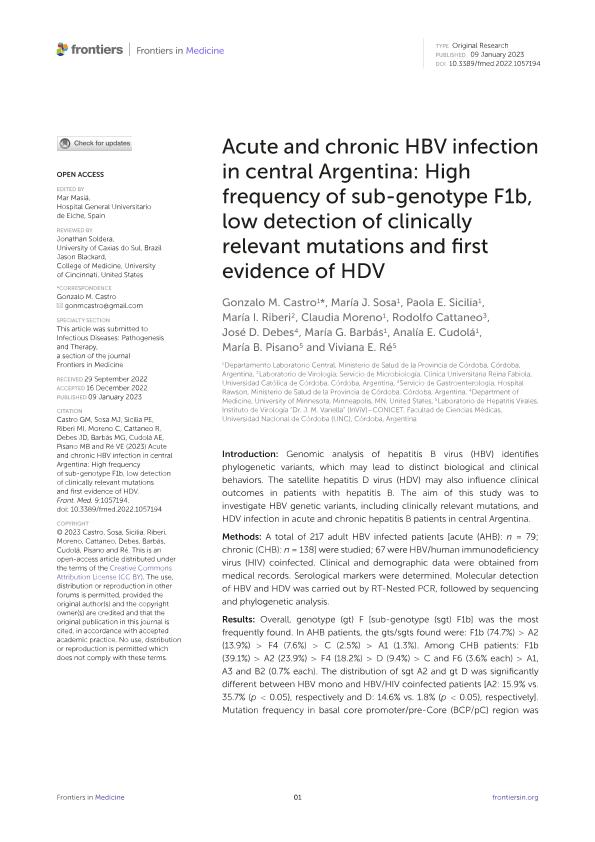Artículo
Acute and chronic HBV infection in central Argentina: High frequency of sub-genotype F1b, low detection of clinically relevant mutations and first evidence of HDV
Castro, Gonzalo Manuel ; Sosa, María J.; Sicilia Don, Paola Ermelinda; Riberi, María I.; Moreno, Claudia; Cattaneo, Rodolfo; Debes, José D.; Barbás, María G.; Cudolá, Analía E.; Pisano, María Belén
; Sosa, María J.; Sicilia Don, Paola Ermelinda; Riberi, María I.; Moreno, Claudia; Cattaneo, Rodolfo; Debes, José D.; Barbás, María G.; Cudolá, Analía E.; Pisano, María Belén ; Ré, Viviana Elizabeth
; Ré, Viviana Elizabeth
 ; Sosa, María J.; Sicilia Don, Paola Ermelinda; Riberi, María I.; Moreno, Claudia; Cattaneo, Rodolfo; Debes, José D.; Barbás, María G.; Cudolá, Analía E.; Pisano, María Belén
; Sosa, María J.; Sicilia Don, Paola Ermelinda; Riberi, María I.; Moreno, Claudia; Cattaneo, Rodolfo; Debes, José D.; Barbás, María G.; Cudolá, Analía E.; Pisano, María Belén ; Ré, Viviana Elizabeth
; Ré, Viviana Elizabeth
Fecha de publicación:
01/2023
Editorial:
Frontiers Media
Revista:
Frontiers in Medicine
e-ISSN:
2296-858X
Idioma:
Inglés
Tipo de recurso:
Artículo publicado
Clasificación temática:
Resumen
Introduction: Genomic analysis of hepatitis B virus (HBV) identifies phylogenetic variants, which may lead to distinct biological and clinical behaviors. The satellite hepatitis D virus (HDV) may also influence clinical outcomes in patients with hepatitis B. The aim of this study was to investigate HBV genetic variants, including clinically relevant mutations, and HDV infection in acute and chronic hepatitis B patients in central Argentina. Methods: A total of 217 adult HBV infected patients [acute (AHB): n = 79; chronic (CHB): n = 138] were studied; 67 were HBV/human immunodeficiency virus (HIV) coinfected. Clinical and demographic data were obtained from medical records. Serological markers were determined. Molecular detection of HBV and HDV was carried out by RT-Nested PCR, followed by sequencing and phylogenetic analysis. Results: Overall, genotype (gt) F [sub-genotype (sgt) F1b] was the most frequently found. In AHB patients, the gts/sgts found were: F1b (74.7%) > A2 (13.9%) > F4 (7.6%) > C (2.5%) > A1 (1.3%). Among CHB patients: F1b (39.1%) > A2 (23.9%) > F4 (18.2%) > D (9.4%) > C and F6 (3.6% each) > A1, A3 and B2 (0.7% each). The distribution of sgt A2 and gt D was significantly different between HBV mono and HBV/HIV coinfected patients [A2: 15.9% vs. 35.7% (p < 0.05), respectively and D: 14.6% vs. 1.8% (p < 0.05), respectively]. Mutation frequency in basal core promoter/pre-Core (BCP/pC) region was 35.5% (77/217) [AHB: 20.3% (16/79), CHB: 44.2% (61/138)]. In the open reading frame (ORF) S, mutations associated with vaccine escape and diagnostic failure were detected in 7.8% of the sequences (17/217) [AHB: 3.8% (3/79), CHB: 10.1% (14/138)]. ORF-P amino acid substitutions associated with antiviral resistance were detected in 3.2% of the samples (7/217) [AHB: 1.3% (1/79), CHB 4.3%, (6/138)]. The anti-HDV seropositivity was 5.2% (4/77); one sample could be sequenced, belonging to gt HDV-1 associated with sgt HBV-D3. Discussion: We detected an increase in the circulation of genotype F in Central Argentina, particularly among AHB patients, suggesting transmission advantages over the other genotypes. A low rate of mutations was detected, especially those with antiviral resistance implications, which is an encouraging result. The evidence of HDV circulation in our region, reported for the first time, alerts the health system for its search and diagnosis.
Palabras clave:
ANTIVIRAL RESISTANCE
,
ARGENTINA
,
GENOTYPES
,
HBV
,
HEPATITIS B VIRUS
,
MUTANT
Archivos asociados
Licencia
Identificadores
Colecciones
Articulos(CCT - CORDOBA)
Articulos de CTRO.CIENTIFICO TECNOL.CONICET - CORDOBA
Articulos de CTRO.CIENTIFICO TECNOL.CONICET - CORDOBA
Citación
Castro, Gonzalo Manuel; Sosa, María J.; Sicilia Don, Paola Ermelinda; Riberi, María I.; Moreno, Claudia; et al.; Acute and chronic HBV infection in central Argentina: High frequency of sub-genotype F1b, low detection of clinically relevant mutations and first evidence of HDV; Frontiers Media; Frontiers in Medicine; 9; 1-2023; 1-15
Compartir
Altmétricas



